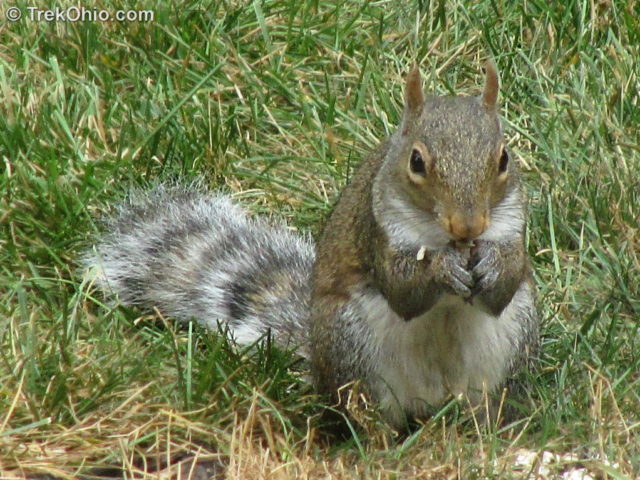
All the squirrels that I am featuring today are Eastern Gray Squirrels (Sciurus carolinensis). Although my focus is going to be on unusually colored squirrels, lets start by taking a look at some normally colored ones. I believe that these squirrels look gray because their fur includes a random mixture of black and white hairs. There are brown hairs, too, but the amount of brown varies greatly among individuals. Nonetheless you can count on the underside of a gray squirrel being white.
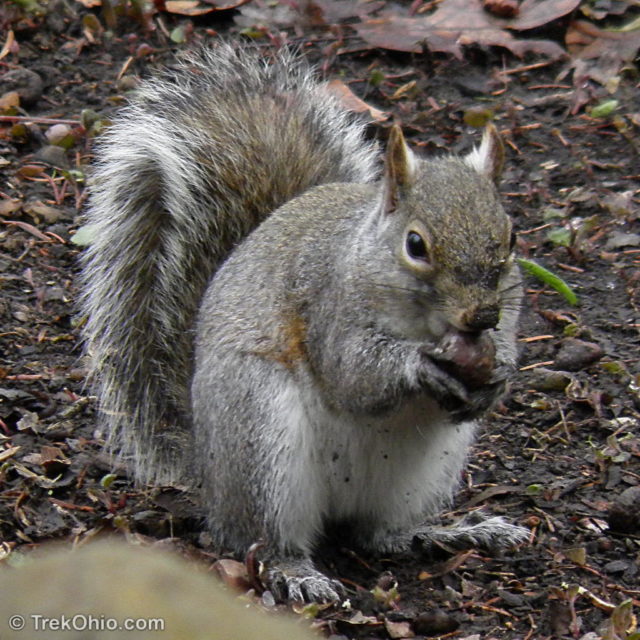
The squirrel below is also a normally colored eastern gray squirrel, but it has a lot more brown hairs in its coat.

Although the ring-tailed squirrel shown in the topmost photo may look like the illicit love child of a raccoon and a squirrel, it is an eastern gray squirrel. Apparently the black and white hairs in its tail aren’t mixed together in the random fashion that is typical of gray squirrels; instead it looks like the white hairs are lined up with other white hairs and the black hairs are lined up with other black hairs, hence the rings. This little guy was a regular visitor to my bird feeder for a while. Interestingly the ring-tailed effect depended on the point of view. When seen from one angle the rings appeared distinctly, but when seen from other angles they seemed to fade away. I can only guess that the rings were part of this squirrel’s genetic make-up. Here’s another look at this odd coloration.
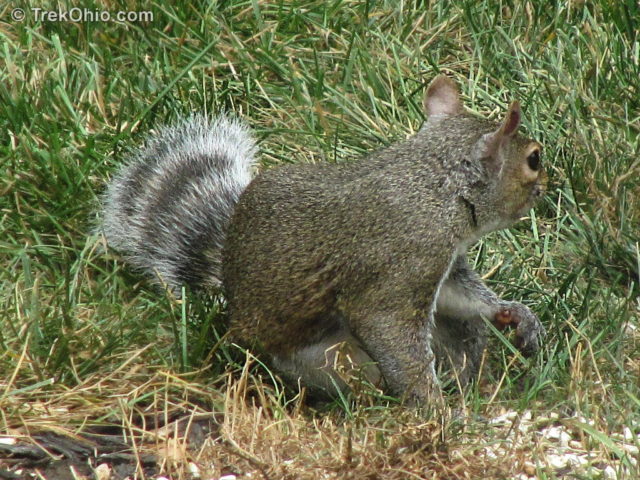
Some gray squirrels lack the white hairs that make the gray squirrel look gray. These are melanistic squirrels and they come in two varieties: pure black vs. black and brown. The pure black squirrels only occur when there is a mutation present in two genes, so it would seem to be a recessive trait. The black-brown varieties have the same mutation, but it’s only present on a single gene. The black coloration appears to offer these squirrels a survival advantage for in cold climates. According to the University of Michigan, black squirrels lose 18% less of their body heat when temperature fall below -10 degrees centigrade.
Although I never see black squirrels where I live in Central Ohio, these squirrels are plentiful around Kent State University (located near Akron, Ohio). According to KentOhio.net, with the permission of American and Canadian Customs, individuals at Kent State University imported a number of black squirrels from Canada in the early 1960s. Today these black squirrels are the dominant squirrels in Kent, and their population has spread to the greater northeastern region of Ohio. The following photos of black squirrels were taken at Kent State University.
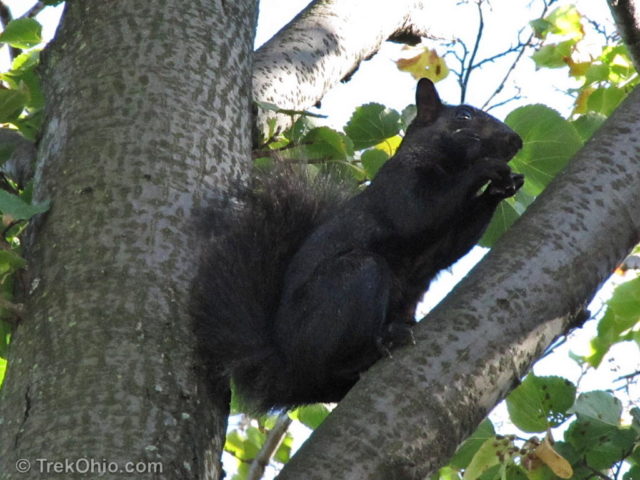
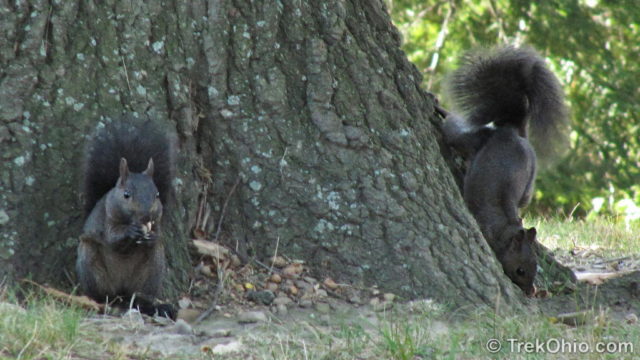
The people of Kent State University love their distinctive, black squirrels. The campus has celebrated them by erecting a statue in their honor.
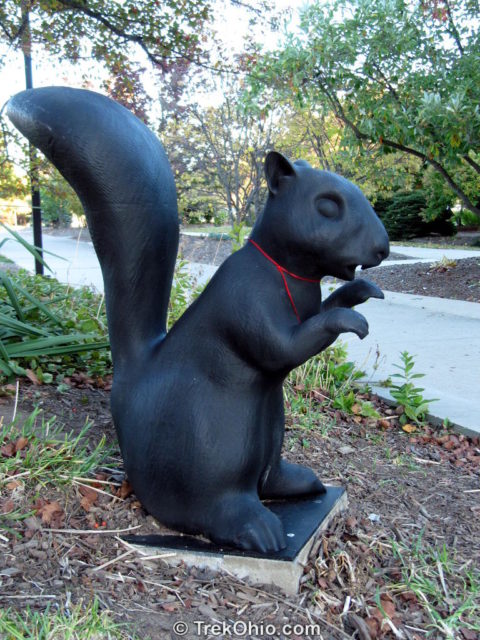
And that brings up to our last color variant: white eastern gray squirrels. Although people often assume that any white squirrel is an albino, most of these white squirrels lack the pink eyes essential to albinism. These dark-eyed, white squirrels are actually leucistic. Note the dark eyes in the squirrel below.
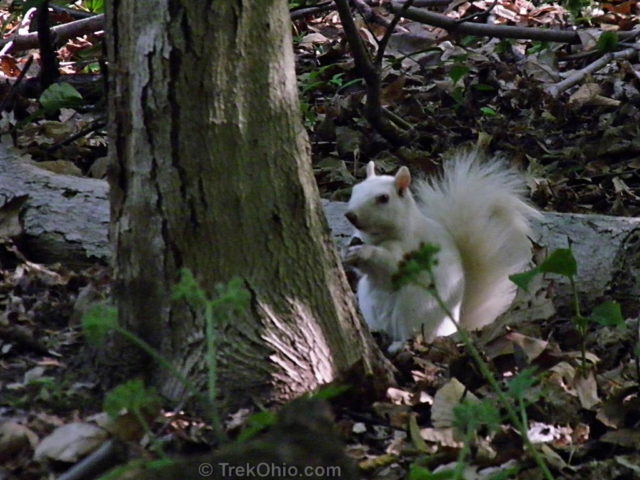
The following squirrel has pink eyes, so it is an albino. It’s a bit hard to see against the snow; click on the photo if you’d like to see a close-up of the squirrel.

Although the white coloration camouflages the squirrel during the winter, the same white makes the squirrel stick out like a sore thumb once the snow melts. I was standing on a hill when I spotted the following white squirrel in the valley below.
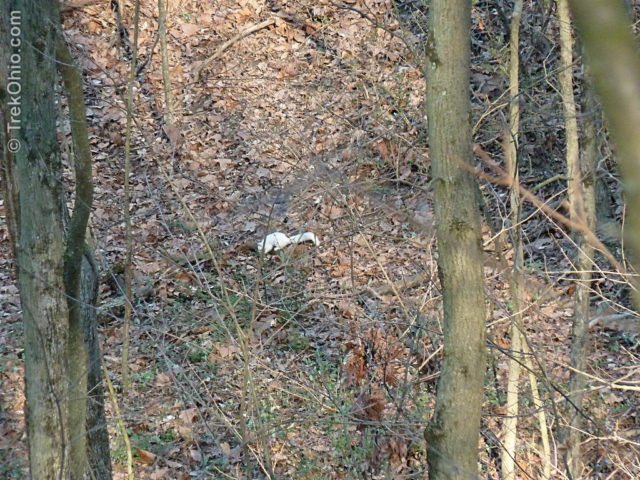
Naturalists believe that white squirrels are more prevalent near urban areas since fewer predators mean that their easy visibility doesn’t endanger them as it would in a wilder area. In Central Ohio I have seen them at two Columbus Metro Parks (Inniswood and Chestnut Ridge). I’ve also seen them in Delaware County at Hogback Ridge Preservation Park.
Here’s a nice contrast between two differently colored, eastern gray squirrels. Below the photo is a short video of this same white squirrel scavenging for food hidden in the mulch.
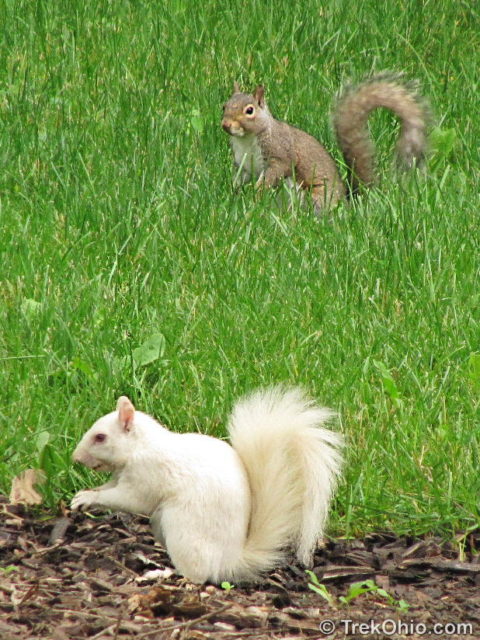
Additional information
- Tree squirrel, published at Wikipedia (includes a discussion of white and albino squirrels)
- Eastern Gray Squirrels, published at Wikipedia
- Black squirrel, published at Wikipedia
- We’re Nuts About Black Squirrels, published by KentOhio.net
- Sciurus carolinensis, published by the University of Michigan under their “Animal Diversity Web”
- Leucism, published at Wikipedia (animals who are white, or partially white, but don’t have pink eyes)
- Albinism, published at Wikipedia
I live in Baton Rouge for 63 years an for the first time in my life I am seeing a blond hair squeral in my back yard,how rear is that
We live in Maryland have a gray squirrel with a brown tail visiting us regularly.
We’ve never seen one like that before.
Is it rare?
I have a brown squirrel with a white abdomen hanging around my birdfeeder here in Western Pa. He has a thin, curled tail. Does anyone know what type of squirrel this is?
I was looking out the window watching the bird feeder, and I couldn’t believe what I was seeing, a dang grey squirrel with a ring tail. I have never seen anything but Grey, Black, Fox and White squirrels. So I googled it and found your article, what a great read. The crazy thing is, I live in Georgia. Didn’t know we had em down here. I can’t wait to take a picture of this crazy little squirrel.
I have a gray squirrel coming to feeder that has golden hairs outlining his ears! It is difficult to get pictures but I am trying!!
Yesterday for the 1st time in 60+ years of living, a ringed tail gray squirrel came into my strawberry patch. We enjoyed watching it for the short time it spent here before the grandchildren got loud. It’s beauty was breathtaking! I hope this squirrel enjoys the fruits, as much as we enjoy watching it.
I live in Willoughby and we have had Siamese squirrels. They Ave a grey body with brown points just like a Siamese cat. I have also seen a black squirrel with a red tail and a grey squirrel with a white tail. I never knew there was such a variety if squirrel colors.
for a while in my part of Michigan when I was much younger there were a large number of eastern gray squirrels with odd colors. ring tailed ones like you saw, but also gray ones with vividly red tails and ones that were all black but with a vivid red tail. also some of the ring tailed ones had dark gray swirling on their sides. I actually remember being able to identify some of those based on the swirling patterns. I also saw an unusually large blue-black one around that time too, it was at least half again as large as the rest. this was sometime back in the late 80’s/early 90’s.
I saw a bluish squirrel in lyndhurst nj on 9/29/17. It looked like a traditional light brownish but had light blue sides. Initially thought I still had my sunglasses on but I didn’t. Is this common.
Bill, no that’s not common. I’ve never seen one with a bluish cast. Did you happen to get a photo of it?
we have all colors here, white black the greys, by the way several years ago I was driving past the neighborhood stable and a black and white squirrels zipped in front of my truck and ran up into the yard across the street (the white following the black every where he went) for some reason the black one decided he wanted to get to the other side of the street where he just came from right in front of me, this is like a second or two timing here, and the white lagging right behind, the black squirrel made it the white did not I ran over him/her.I could see in my rearview, I felt really bad I tried to stop but to no avail it ran up under my wheel. poor squirrel. I think they are adorable and wish I could pet one they look really soft.
rose
It’s too bad about the white squirrel, but you shouldn’t blame yourselves.
I wouldn’t try to pet a wild squirrel, but I’ve been in parks where they are accustomed to being fed by people and will take treats from your hand.
I’ve seen the black squirrels… Having lived in Arlington, VA for a stint, that’s all we had, actually! But WHITE! I’ve never seen, or even heard of! Fascinating, and just lovely!!
I was so thrilled the first time that I saw a white squirrel. I’ve since seen a number of them, so it may not be as thrilling now, but it’s still fun. 🙂
Awesome! I don’t know there are black and white squirrels. This post made my day 🙂 And oh yeaah they try the best they can to get to bird feeders.
Marviiilous, while I was researching this post I learned more about the squirrel species that we have in Ohio. And I think I discovered what kind of squirrel Rusty is. I believe that he is a fox squirrel. They have reddish-orange bellies and tails.
Rusty the fox squirrel! It sounds so cool! 🙂
That’s the (only) species I’ve seen in Fort Smith, Ar so far. I haven’t seen other than that yet. Thanks for finding Rusty’s species. you rock!